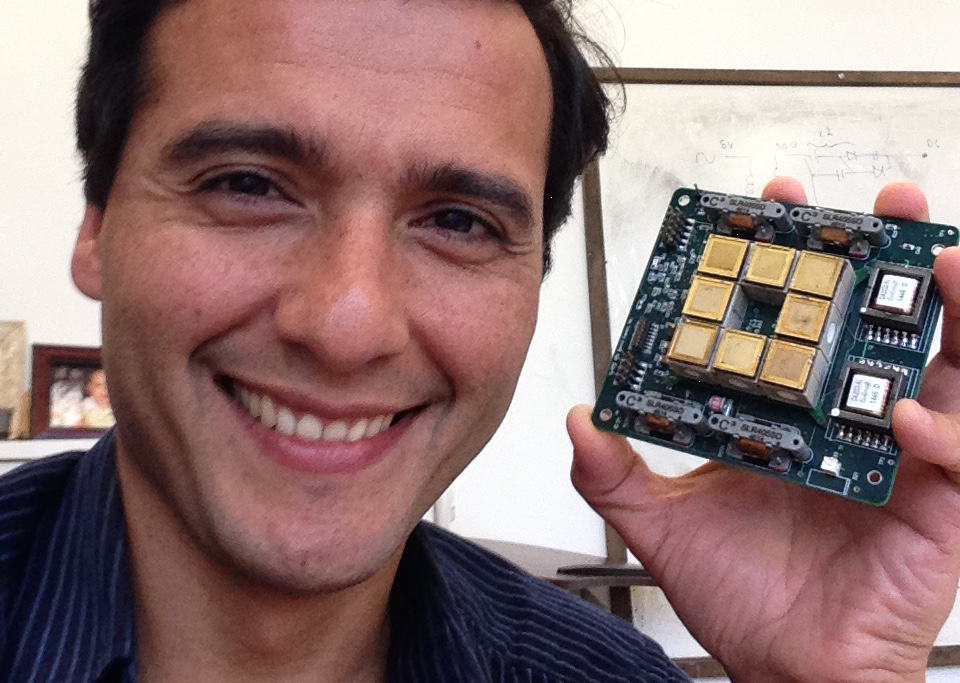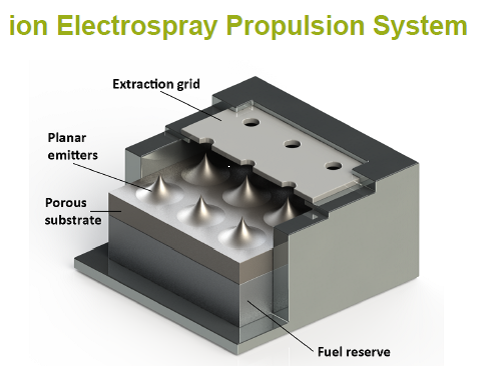
Tiny is the new huge: microthrusters for miniature satellites
Paulo Lozano shows off part of a cubesat using the microthrusters under development in his MIT laboratory. (MIT photo)
The new big thing in space is small—cubesats. A miniature satellite or cubesat is a box a few inches on a side, around a liter in volume and weighing about as much as a medium-sized pumpkin. Cubesats have been on the space scene for about 15 years, with hundreds launched, but many still regard them as little more than toys.
However, cubesats can do many things that large satellites do. They provide imaging, communication, navigation, scientific research and weather tracking. Their marginal place in spacecraft respect arises because they share not only the mass but also the mobility of pumpkins. Once they are put in a specific orbit, they are adrift. Only natural forces bring them down. They fall into the atmosphere and burn up. They cannot change altitude, they cannot reorient, they cannot form precisely positioned data-collecting fleets and they cannot navigate out of the way of orbital debris—goodbye, cubesat. They are helpless.
But help is on the way. Paulo Lozano at the Space Propulsion Laboratory at MIT has recently tested, after years of development, a micro-electrospray propulsion system. Each unit is smaller in diameter than a quarter. These microthrusters’ descendants may soon allow mini satellites to shift their orbits around Earth, and perhaps take them on deep space missions. With such space access coming in range of small organizations and even individuals, we are part of a new space revolution, says Lozano.
“I mean, space is fun again,” Lozano said in an interview after his Oct. 12 presentation during CASW’s New Horizons in Science program at the ScienceWriters2015 conference at MIT.
Even without navigation ability, cubesats’ attractions are clear. They are relatively cheap. They do not take armies of specialists to build. Regular people might fabricate one for $10,000 or so. Many of them can go up together in a single launch, cutting delivery costs, and if they are banged up or wrecked during a mission, the loss is not as hard to absorb as with larger versions.
Miniaturizing the thrust
Lozano did not start off designing tiny propulsion systems for cubesats. When they first came out, he was not a believer.
“How much can they do?” asked Lozano.”A tiny little satellite doing really interesting stuff? No.”
He was interested in propulsion for larger satellites. But he also knew that he could test cubesat-scale propulsion in small chambers.

“The first thing we tried was to miniaturize a plasma thruster,” Lozano said. “It was bad. They don’t like to be miniaturized.”
Plasma thrusters are the standard for maneuvering satellites in space after the satellites have been launched. After this failed attempt, Lozano’s team got funding and spent a little over a year working on the first generation of micro-electrospray thrusters. Like plasma thrusters they eject ions to produce a thrust, but their detailed engineering is very different.
“It works the same way as a candle,” Lozano said in his New Horizons talk, “except we are evaporating ions.”
Within a small square box, positive or negative ions from liquid salt are pulled by the capillary effect through microscopic, porous, conelike projections arrayed as a grid. Those ions are then electrically charged and converted into ion beams. If one has enough of those beams, one has enough thrust for a cubesat. Power to charge the thruster comes from solar cells mounted on the cubesat.
Not exactly a candle.
Initial testing of the electrospray thruster was far more promising than their earlier miniaturized plasma thruster.
The first runs only lasted about ten seconds before the devices failed. But the team was excited. Lozano was animated as he exclaimed about this not-so-small accomplishment,
“That’s very cool!” he said. “It’s great!”
When cubesat deployment started to accelerate in 2011, Lozano and his team began working even harder. A ten-second run is not going to be enough to give a pumpkin much of a shove, even in space. And to be part of the new space revolution, the team had to work fast.
The big payoff
This summer Lozano and his team conducted the first realistic, successful fires of the microthrusters. They attached two microthrusters to a cubesat, one on either side, floated the cubesat in a vacuum chamber, and fired the thrusters. They published their initial results as a paper for the 34th International Electric Propulsion Conference in Hyogo-Kobe, Japan in July.
In what Lozano playfully referred to as a “boring demonstration” because of the lack of light the thrusters give off, Lozano showed a video of the cubesat spinning at two revolutions a minute. Not bad for two thrusters. Then in a separate test they fired a thruster continuously for 140 hours to see if the fuel would be exhausted.
“It wasn’t clear if we would be able to get all the ions out. But we did. The tank was dry,” Lozano said when he displayed the tiny depleted fuel tank.
And with no corrosion, an efficient propulsion system unlikely to harm other satellite components seemed to be in hand.
And now…space?
Lozano’s team has sent three eight-module propulsion units to NASA for testing. If NASA’s on-ground testing goes well, they could soon be sent into orbit. Lozano and his team are currently working on units that can deal with the bigger challenges of space travel outside of Earth orbit—longer missions and increased data capabilities within such a tiny package. This is their plan for the upcoming year.
For everyone else, Lozano says these candle-driven pumpkins will be available for purchase soon. And the promises of decades ago about a new era in which millions of people can work in space should become a reality.